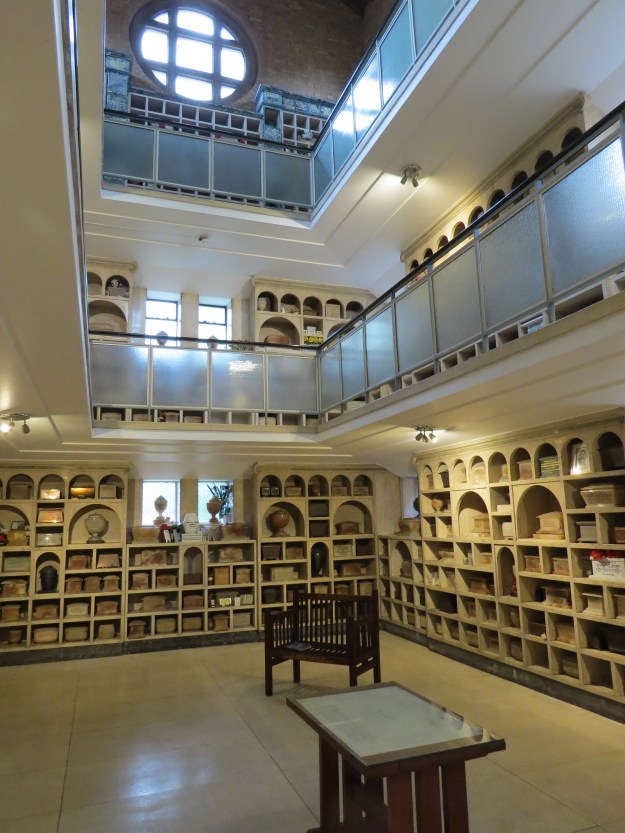
Dear Readers, today we decided to take a look at Golders Green Crematorium, and its memorial gardens. This is the first crematorium to built in London (it was opened in 1902): cremation only became legal in the UK in 1885, with the first crematorium being built in Woking in 1878 as part of the cemetery there. Cremation was championed by the Cremation Society of Great Britain – it was believed that the burning of remains was much healthier than burial, and as many city cemeteries were full, it was seen as a more practical way to deal with the dead. A declaration stated that
“We, the undersigned, disapprove the present custom of burying the dead, and we desire to substitute some mode which shall rapidly resolve the body into its component elements, by a process which cannot offend the living, and shall render the remains perfectly innocuous. Until some better method is devised we desire to adopt that usually known as cremation.”
Some of the undersigned included Anthony Trollope, John Everett Millais and the illustrator John Tenniel, along with the president of the Cremation Society, Sir Henry Thompson.
Since it opened, Golders Green Crematorium has held more than 323,500 cremations, more than any other crematorium in the country. In an average year there are 2,000 cremations, with three chapels being available for the services. The crematorium is secular and open to people of all faiths and none.
I was struck by how different the memorial gardens are: without any graves, people are remembered by plaques which might accompany rose bushes, or trees, or shrubs. The gardens are remarkably peaceful, even on a Bank Holiday.

The Lily Pond in the Memorial Gardens
I loved this purple magnolia, its flowers just about ready to open. At least, I think it’s a magnolia. Enlighten me if not, readers!

I liked this statue of G.D. Birla, an Indian businessman, writer and philanthropist who was a close associate of Mahatma Gandhi.

Statue of G.D. Birla
And here is a memorial bench to Marc Bolan, who died in a car accident in 1977 at the age of 29. For those of you too young to remember, the swan refers to the T-Rex hit ‘Ride a White Swan‘, a big favourite when I was, ahem, 10 years old.

There are some stunning acers…


…some fine Japanese anemones…

and a very fine pond, with a magpie happily trawling for titbits on the plants.



I was very taken by this sculpture by Henry Pegram, called ‘Into the Silent Land’. It was gifted to the crematorium by the Royal Society of Arts in 1937, the year of Pegram’s death.

This extraordinary building is the Philipson Mausoleum, designed by Sir Edwin Lutyens and built in 1914. It was built originally to house the remains of Florence Philipson, and when her husband RH Philipson died, he stipulated that his money should be given to a home for boys in his birthplace, Newcastle, with any remainder being used to preserve the mausoleum. It’s an extraordinary design – roses were to be planted between the inner and outer walls, and originally the oculus in the dome was open to the sky (like the Pantheon in Rome), with an upturned basin underneath to catch rainwater. Sadly, today it’s padlocked, and the dome (the oculus is now glazed) looks increasingly like the hanging gardens of Babylon.

The Philipson Mausoleum, designed by Lutyens

Intriguingly, there is a ‘Communist’s Corner’, where the plaques of communists past and present are collected together.

‘Communists Corner’


What a wonderful vista along the cloisters!

One feature that I hadn’t seen before is a columbarium: this is a room that stores the funerary urns in niches. The range of choices that have to be made when someone dies can sometimes be overwhelming – to cremate or to bury? To scatter or to store? The variations on each theme multiply like a particularly complex flow chart. It’s really helpful to know what the loved one wanted in advance, so thanks to Mum and Dad for their foresight.

And finally, on the way out I was much taken by this plaque. ‘Mors janua vitae’ means ‘Death is the Gateway to Life’. Historic England describe it as ‘a plaque in Art Nouveau style’, which indeed it is, though I can’t find out if there is anything that links those who are commemorated on it. Nonetheless, it’s another sign of how much there is to explore at the crematorium and the memorial gardens. I shall certainly be visiting again. For one thing, I completely missed the ‘Freud Corner’, where the funerary urns of Sigmund Freud and his family are held, and it would be good to find and pay my respects to Joyce Grenfell, one of the funniest comedians of her (and any) generation.

This has been a fascinating exploration!
I always learn so much from your posts. My only knowledge of Golders Green was the poem Death Wish, by Spike Milligan. The poem makes a lot more sense now! I used to wonder if the “burn” at the end was a typo and was supposed to by “bury,” but of course, it turns out that “n” is the crucial part! Milligan wasn’t opposed to the location, but to the method.
Death Wish
Bury me anywhere,
Somewhere near a tree
Some place where a horse will graze
and gallop over me.
Bury me
Somewhere near a stream,
When she floods her banks
I’ll give her thanks
For reaching out to me
In my childhood scene;
But please –
don’t burn me
In Golders Green.
Aha! Thanks for this, sllgatsby – I hadn’t come across it before, but it fits perfectly. Milligan lived in Finchley for many years so this would have been his ‘local’ crematorium.